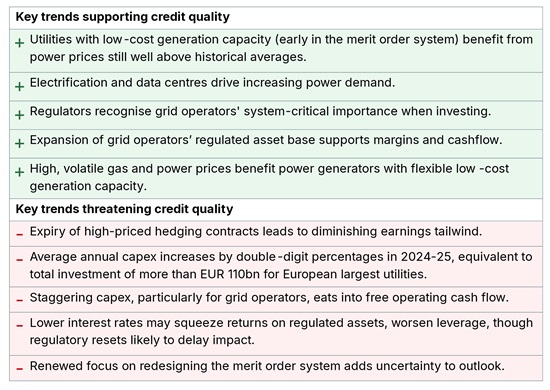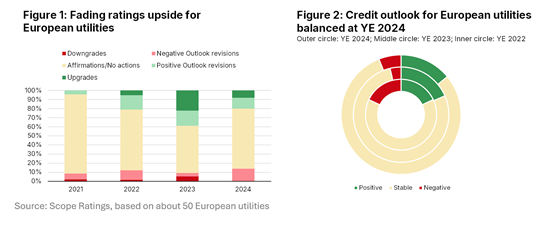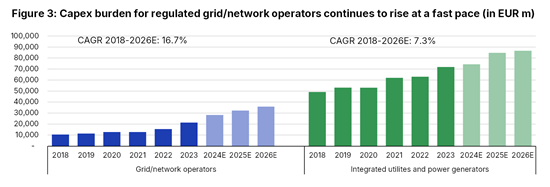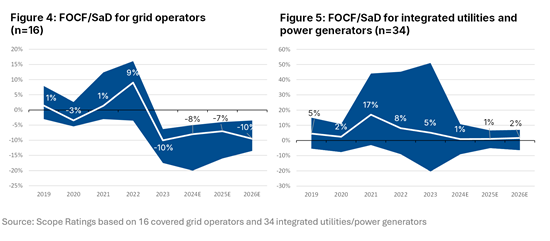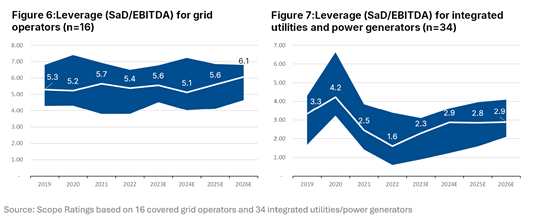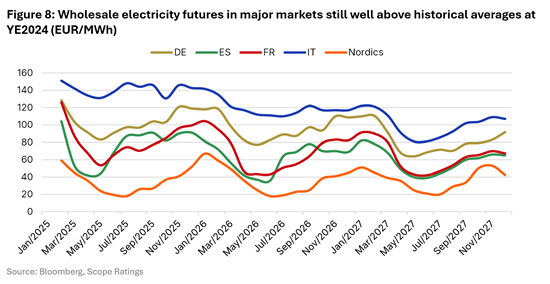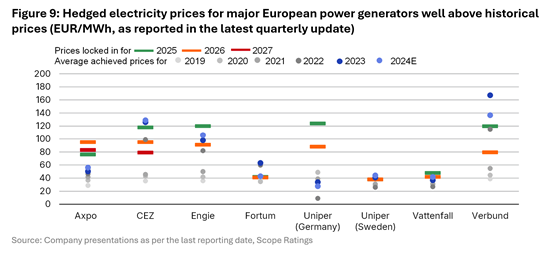Announcements
Drinks
European utilities: less price support, more capex leave credit outlook less positive but balanced
The expiry of favourable hedges will lead to earnings normalisation, putting the focus back on balance sheets given the sector’s record-high investment requirements. Managing financial flexibility and securing funding for grid expansion and renewable-energy projects will be critical.
Despite these challenges, the sector outlook remains balanced due to the solidity of corporate balance sheets and the prudent measures that utilities, particularly grid operators, have deployed to counter cash outflows (negative free operating cashflow).
Balanced rating outlook for European utilities
The positive ratings drift over 2023-2024 is likely coming to an end, as shown by a more balanced distribution of credit outlooks at the end of the 2024 financial year. Ratings upside looks more modest for integrated utilities and power generators with low-cost generation fleets compared with 2023-24.
First, support from power prices for operating cash flow is gradually fading. Secondly, utilities are still using the financial headroom earned over the past few years for more ambitious capital spending and/or mergers and acquisitions. The downward pressure on the ratings of regulated utilities that face ever-increasing capital spending requirements is more intense, but manageable for the time being.
Growing capex challenge impacts credit ratios
The funding needed for capex remains a big challenge for European utilities (Figure 3), particularly for regulated grid operators. These companies need to expand and modernise electricity grids to cope with the rising volumes of intermittent solar- and wind-powered electricity supplied to the network, growing electricity demand and the need to improve grid resilience.
This year, the capex requirement at larger European grid operators will rise sharply again, contributing to double-digit CAGR of about 17% for 2018-26E. Netherlands-based TenneT NV and Belgium-based Elia SA are good examples, set to shoulder capex of EUR 11bn and EUR 4.9bn respectively in 2025 which is more than 60% higher than the three-year average in 2022-24E.
Not just the national grid operators, but even the smaller grid operators such Dutch operators Alliander NV and Enexis NV face rising capex bills too given their focus on electricity distribution in areas with high grid congestion and a much larger number of renewable feed-in points. The utilities face an estimated capex increase at EUR 1.8bn and EUR 1.6bn respectively, 30-40% above the three-year average for 2022-2024E.
Since grid operators rely on regulated returns and tariff adjustments, they lack immediate revenue uplift from market prices. As such, the combination of high capex and weaker free cash flow generation puts pressure on the utilities’ ability to self-fund investments, leading to continued reliance on external financing (Figure 4). Relief will come only in the medium to long term when the companies receive the corresponding capital return on their increased regulated asset base.
In contrast, integrated utilities and power generators are better positioned to manage capex demands. True, their investment needs remain high in 2025. Take the EUR 23.3bn forecasted for Eléctricité de France SA and EUR 11.1bn for French rival Engie SE, EUR 10.7bn for Italy’s Enel SpA and EUR 10.1bn for Spain’s Iberdrola SA, particularly in renewables and grids. However, their ability to generate earnings from selling electricity helps them keep FOCF closer to breakeven on average (Figure 5).
Turning to hybrid debt one way for utilities to cope with rising capex burden
Integrated utilities still have room for manoeuvre to manage capex and minimise the strain on balance sheets by:
- Spreading capex over the medium term to maximise the extra borrowing their balance sheets can support
- Taking further advantage of the re-opened hybrid debt market amid lower base rates and reduced risk premia favourable for utilities ratings
- Readjusting shareholder remuneration during this period of elevated capex.
As such, utilities should be able to offset negative ratings pressure, though regulated grid operators need to remain alert to sustained structural deterioration in leverage in 2026 and beyond (Figure 6), while integrated utilities and power generators are better placed for keeping leverage under control (Figure 7).
Electricity prices in Europe: what has changed for the utilities?
Forward and spot electricity prices remain well above historical averages, but the expiry of hedges that allowed utilities to lock in exceptionally strong margins – particularly for generators with low production cost – will lead to less strong earnings and cashflow this year and next.
During the European energy crisis, utilities benefited from long-term hedging strategies that secured high power prices, significantly boosting earnings and cash flow generation. These hedges helped stabilise financial performance, allowing many companies to deleverage and strengthen their balance sheets.
As these favourable hedges roll off, future earnings will be increasingly exposed to prevailing market conditions, which – despite still-elevated prices – are unlikely to sustain the extraordinary profitability of 2022-23 (Figures 8, 9). Utilities which accrued large cash cushions over the past three years have used or will use their balance-sheet headroom for more ambitious growth via capex and/or M&A.
As a result, leverage metrics for power generators and integrated utilities are expected to normalise. The shift may lead to weaker credit metrics compared with recent highs but no more than a return to more sustainable, pre-crisis levels.
